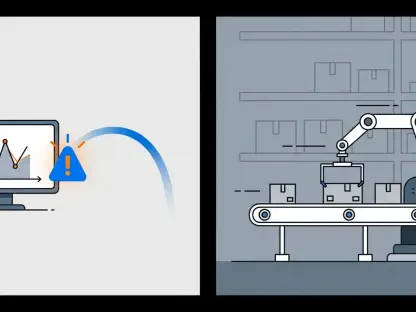Could a sudden gust of wind derail an entire day’s energy production on a sprawling wind farm, costing thousands in losses and risking critical infrastructure? This scenario haunts operators worldwide as wind power becomes a backbone of renewable energy, yet remains at the mercy of nature’s unpredictability. In Spain, where wind energy accounted for 23.2% of the national grid in recent years, the stakes are higher than ever. Artificial intelligence (AI) is emerging as a powerful ally, promising to transform how wind speeds are forecasted with unprecedented precision. This exploration uncovers how cutting-edge AI tools are poised to safeguard farms and boost efficiency in an era of climate uncertainty.
Unlocking the Power of Wind with AI: A Game-Changer for Farms
At the heart of renewable energy innovation, AI stands as a beacon of hope for wind farm operators grappling with erratic weather patterns. Unlike traditional forecasting methods that often fall short under complex conditions, AI leverages vast datasets to detect patterns invisible to older systems. This technological leap offers a chance to not only predict wind behavior but to do so with a level of detail that could redefine operational strategies across the industry.
The significance of this shift cannot be overstated. With AI, farms gain the ability to anticipate wind speeds over short- and long-term horizons, enabling better planning for energy output and maintenance schedules. This isn’t just about numbers—it’s about building resilience against sudden storms and ensuring that clean energy remains a reliable resource for millions. The potential to minimize downtime and protect equipment marks AI as a transformative force in the sector.
Why Wind Speed Predictions Matter More Than Ever for Wind Farms
Wind energy’s role in global sustainability goals is undeniable, yet its dependence on consistent wind patterns poses a constant challenge. Farms must balance the need to maximize power generation with the risk of damage from unexpected high-speed gusts that can strain turbines beyond repair. Accurate predictions are the linchpin for maintaining this delicate equilibrium, directly impacting grid stability and economic viability.
Beyond immediate operational needs, precise forecasts contribute to broader energy security. When farms can reliably estimate their contribution to the grid, energy providers can better manage supply and demand, reducing reliance on fossil fuel backups. This ripple effect underscores why advancements in forecasting are critical, especially as climate change intensifies weather extremes, making every prediction a step toward a more sustainable future.
Moreover, the financial implications are stark. Unpredicted wind events often lead to forced shutdowns, racking up losses in both revenue and repair costs. Enhancing prediction accuracy means fewer such disruptions, allowing operators to allocate resources more effectively and push forward with confidence in wind as a cornerstone of clean energy.
AI-Driven Innovations in Wind Speed Forecasting
Groundbreaking research from a leading Spanish university has introduced two AI methodologies that are reshaping wind speed forecasting. Built on artificial neural networks and ordinal classification systems, these models categorize wind speeds into distinct ranges—low, moderate, high, and extreme—rather than offering mere numerical guesses. Trained on over a decade of data, including wind components, air pressures, and temperatures, they provide forecasts for 1-, 4-, and 8-hour windows, catering to diverse operational needs.
The first model delivers consistent accuracy across all wind speed categories, making it a versatile tool for daily planning. Meanwhile, the second model shines in detecting extreme gusts exceeding 20 meters per second, achieving a remarkable 94% accuracy rate. This precision is vital for preempting turbine damage during severe weather, addressing one of the most pressing risks faced by wind farms today.
These innovations highlight AI’s capacity to tackle specific challenges in the field. By focusing on both routine and emergency scenarios, the models offer a dual approach that could set a new standard for forecasting. As these tools evolve, they promise to bridge the gap between theoretical research and practical application, paving the way for safer, more efficient wind energy production.
Voices from the Field: Insights and Real-World Impact
Experts behind this research emphasize the game-changing potential of AI in wind energy management. Antonio Gómez, a key researcher, points out the adaptability of these models across various timeframes, ensuring relevance for both short-term adjustments and longer-term strategies. This flexibility is a crucial advantage in an industry where conditions can shift rapidly.
David Guijo, another lead researcher, highlights the life-saving accuracy of predicting extreme wind events: “Knowing gusts over 20 meters per second are coming with 94% certainty can avert catastrophic turbine failures.” Pedro Antonio Gutiérrez adds that such precision strengthens grid integration, a priority for energy providers striving for seamless renewable incorporation. These insights reflect a unified vision of AI as a tool for both safety and systemic improvement.
Real-world applications are already showing results. At a test wind farm, operators have reported noticeable reductions in downtime during harsh weather, thanks to early warnings from these AI models. Such outcomes validate the technology’s practical worth, demonstrating that lab innovations can translate into tangible benefits on the ground, bolstering confidence in wider adoption.
Practical Steps for Implementing AI in Wind Speed Predictions
For wind farms looking to harness AI’s predictive power, a structured approach is essential. The initial step involves partnering with data scientists to gather or access localized datasets that capture variables like wind speeds and atmospheric conditions over extended periods. This foundation ensures that models are tuned to the unique characteristics of each site, maximizing their effectiveness.
Selecting the right AI model is the next critical decision—whether prioritizing balanced accuracy for everyday operations or focusing on extreme event detection for safety. Training and validating the model with site-specific data, as demonstrated in recent studies, are non-negotiable for achieving reliable results. Finally, integrating these forecasts into real-time systems allows for immediate actions, such as scheduling maintenance or initiating shutdowns during high-risk periods.
While adapting models to new locations requires retraining, this process is a scalable blueprint for global implementation. Farms worldwide can start small, testing AI tools on a single site before expanding, thereby building a robust framework for forecasting. This pragmatic pathway offers a clear route to leveraging AI, ensuring that even smaller operations can benefit from cutting-edge technology.
Reflecting on AI’s Transformative Journey in Wind Energy
Looking back, the strides made in integrating AI into wind speed forecasting marked a pivotal chapter for renewable energy. The dual models developed by dedicated researchers provided a lifeline, with one achieving over 94% accuracy in predicting devastating gusts, while the other ensured steady reliability across all conditions. These breakthroughs redefined how farms approached weather challenges, turning uncertainty into actionable insight.
The path forward demanded collaboration—between operators, scientists, and policymakers—to scale these solutions across diverse regions. Investing in localized data collection and model retraining emerged as vital next steps to ensure universal applicability. By embracing these efforts, the industry stood poised to strengthen wind power’s role in global energy grids, fortifying resilience against an unpredictable climate.









